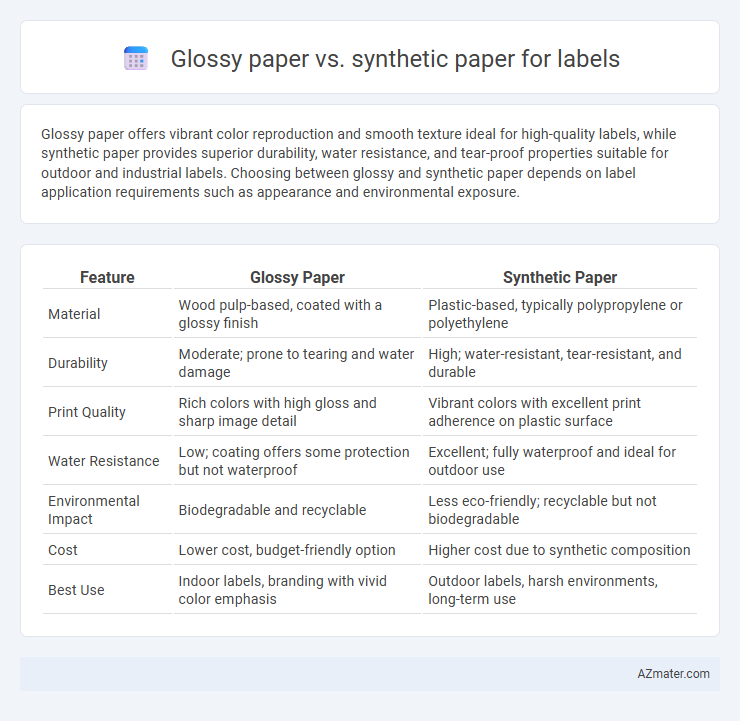Glossy paper offers vibrant color reproduction and smooth texture ideal for high-quality labels, while synthetic paper provides superior durability, water resistance, and tear-proof properties suitable for outdoor and industrial labels. Choosing between glossy and synthetic paper depends on label application requirements such as appearance and environmental exposure.
Table of Comparison
| Feature | Glossy Paper | Synthetic Paper |
|---|---|---|
| Material | Wood pulp-based, coated with a glossy finish | Plastic-based, typically polypropylene or polyethylene |
| Durability | Moderate; prone to tearing and water damage | High; water-resistant, tear-resistant, and durable |
| Print Quality | Rich colors with high gloss and sharp image detail | Vibrant colors with excellent print adherence on plastic surface |
| Water Resistance | Low; coating offers some protection but not waterproof | Excellent; fully waterproof and ideal for outdoor use |
| Environmental Impact | Biodegradable and recyclable | Less eco-friendly; recyclable but not biodegradable |
| Cost | Lower cost, budget-friendly option | Higher cost due to synthetic composition |
| Best Use | Indoor labels, branding with vivid color emphasis | Outdoor labels, harsh environments, long-term use |
Overview: Glossy Paper vs Synthetic Paper for Labels
Glossy paper labels offer vibrant color reproduction and a smooth, shiny finish, making them ideal for high-quality, eye-catching product branding. Synthetic paper labels provide superior durability, water resistance, and tear resistance, ensuring longevity in harsh environments or outdoor use. Choosing between glossy paper and synthetic paper depends on whether aesthetic appeal or durability is the primary requirement for the label's application.
Material Composition and Characteristics
Glossy paper labels, made from coated wood pulp fibers, offer a smooth, reflective finish with vibrant color reproduction but tend to absorb moisture and tear easily. Synthetic paper labels consist of durable plastic polymers such as polypropylene or polyethylene, providing water resistance, tear resistance, and enhanced durability in harsh environments. The choice between glossy paper and synthetic paper impacts label longevity, print quality, and suitability for specific applications like outdoor exposure or product packaging.
Print Quality and Visual Appeal
Glossy paper offers vibrant color reproduction and sharp image details, enhancing the visual appeal of labels with a smooth, reflective finish ideal for high-resolution printing. Synthetic paper provides superior durability and resistance to moisture and tearing while maintaining a consistent print quality with vivid colors and excellent clarity. Both materials support high-quality printing techniques, but glossy paper excels in aesthetic brilliance, whereas synthetic paper ensures longevity and resilience.
Durability and Resistance to Elements
Glossy paper labels offer vibrant color reproduction but tend to have lower durability and limited resistance to moisture, tearing, and chemicals compared to synthetic paper labels. Synthetic paper, often made from polypropylene or polyethylene, provides superior durability with excellent resistance to water, oils, chemicals, and UV exposure, making it ideal for harsh environments. This enhanced resistance ensures that synthetic labels maintain legibility and adhesion over time, outperforming glossy paper in demanding applications.
Adhesion Performance: Which Stays Better?
Glossy paper labels offer strong initial adhesion due to their smooth, printable surface but may weaken when exposed to moisture or oils, causing peeling or curling over time. Synthetic paper labels, made from durable materials like polypropylene or polyethylene, maintain excellent adhesion under various environmental conditions, including humidity, abrasion, and chemicals. For applications requiring long-lasting labels with consistent adhesion, synthetic paper outperforms glossy paper, ensuring better durability and resistance.
Cost Comparison: Glossy vs Synthetic Paper
Glossy paper labels generally cost less than synthetic paper labels due to lower material and production expenses, making them suitable for budget-sensitive projects. Synthetic paper labels, while more expensive upfront, offer superior durability, water resistance, and tear resistance, which can reduce long-term replacement and maintenance costs. The choice between glossy and synthetic paper labels ultimately depends on the balance between initial cost and the required durability for specific labeling applications.
Environmental Impact and Sustainability
Glossy paper labels, typically made from wood pulp, are biodegradable but often coated with plastic or clay, which hinders recyclability and increases environmental impact. Synthetic paper labels, made from plastic resins like polypropylene or polyethylene, offer durability and water resistance but are less biodegradable and pose challenges for waste management due to their petroleum-based composition. Sustainable labeling solutions increasingly prioritize recyclable or compostable materials and look to innovations in biodegradable synthetic alternatives to reduce ecological footprints.
Application Suitability: Industries and Use Cases
Glossy paper labels excel in industries like retail and food packaging due to their vibrant color reproduction and high-quality finish, ideal for product branding and promotional materials. Synthetic paper labels, made from durable materials such as polypropylene or polyester, are preferred in harsh environments like chemical, automotive, and outdoor applications where water resistance, tear resistance, and longevity are critical. Choosing between glossy and synthetic paper depends on specific use cases, balancing aesthetic appeal with durability requirements for optimal label performance.
Customization Options and Flexibility
Glossy paper offers vibrant color reproduction and a smooth finish, ideal for high-quality label customization with various printing techniques like UV and digital printing. Synthetic paper provides superior durability and water resistance, supporting flexible design options such as tear resistance and weatherproofing for labels used in harsher environments. Both materials accommodate different customization needs, with glossy paper excelling in aesthetic appeal and synthetic paper offering enhanced performance and longevity.
Choosing the Right Label Material for Your Needs
Glossy paper labels offer vibrant color reproduction and a smooth finish ideal for high-impact branding on indoor products, while synthetic paper provides superior durability, water resistance, and tear-proof qualities suitable for outdoor or harsh environments. Selecting the right label material depends on the application requirements, such as exposure to moisture, abrasion, and the desired visual appeal. Synthetic paper labels often outperform glossy paper in longevity and weather resistance, making them essential for products needing long-lasting identification.

Infographic: Glossy paper vs Synthetic paper for Label
 azmater.com
azmater.com